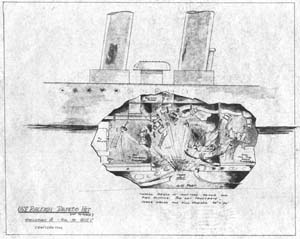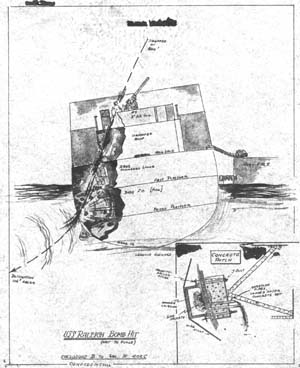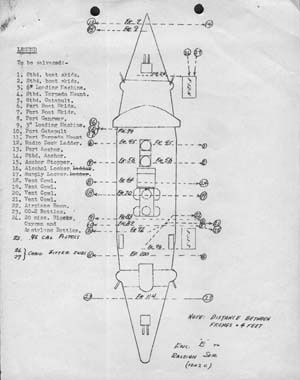| CL7/S88/L11-1/A9 (1202-C) |
U.S.S. RALEIGH |
| CONFIDENTIAL | January 14, 1942. |
- - - - - - - - - - - - - - - - - - - - - - - - - - - - - - - - - - - - -
|
The problem of maintaining buoyancy and stability cannot be considered separately from time of bomb hit, as free flooding, extensive free surfaces, and great loss of buoyancy made solution a progressive one using every expedient to meet constantly changing situation throughout period of recovery. Counterflooding and pumping out of forward starboard magazines and forward port shaft alley were only voluntary shifting of liquids. Topside gear such as catapults, airplanes, torpedo tubes and mounts, torpedoes, boat-skids, anchors and chains, gangways, booms, loading machines, gear lockers and chests, life-rafts, etc., were jettisoned to prevent capsizing, first from port side and later when ship suddenly reversed list, to starboard side, Estimated weight of this gear totals about 60 tons, and all was accomplished by manpower. Another step taken to prevent capsizing was strapping a barge bearing four 80-ton salvage pontoons to port quarter. As equipment and power for locating pontoons were not available, entire barge was attached as a veritable outrigger by passing four 2" wire hawsers completely about hull of RALEIGH and barge, and then passing wire straps about top and bottom parts where they crossed between ship and barge. By coming up taut on those latter straps entire barge was securely fixed in place against hull. As soon as it was possible, oil soaked gear and bedding was removed from ship and compartments wiped down to reduce the constant menace of fire. Also 3500 gallons of aviation gasoline which bomb had fortunately missed by a matter of feet was transferred to a gasoline barge. Spoiled meat from flooded refrigerator was removed and non-perishable commissary stores wero recovered and restowed clear of damaged area.
|
- 11 -



